
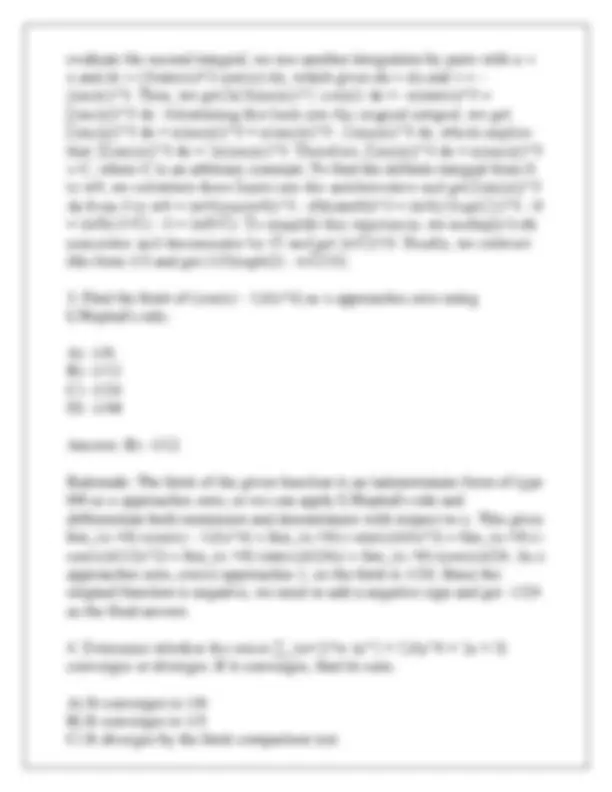
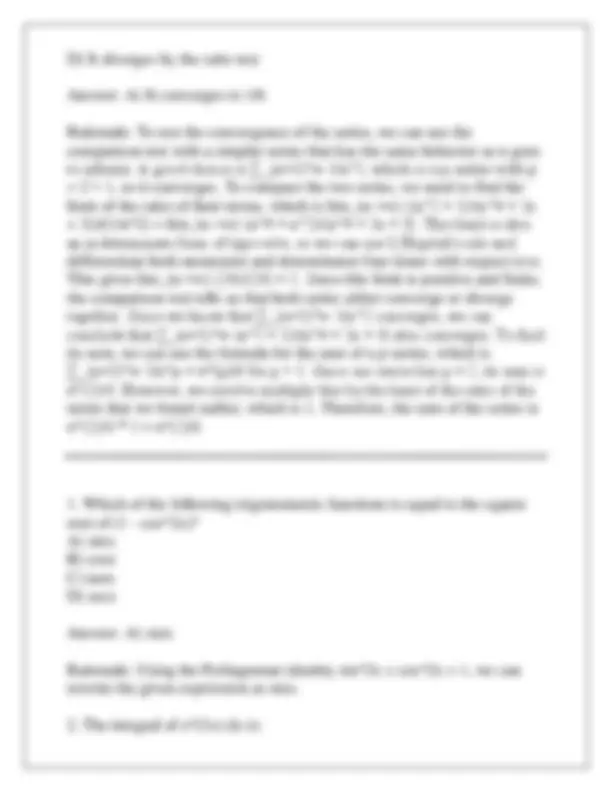
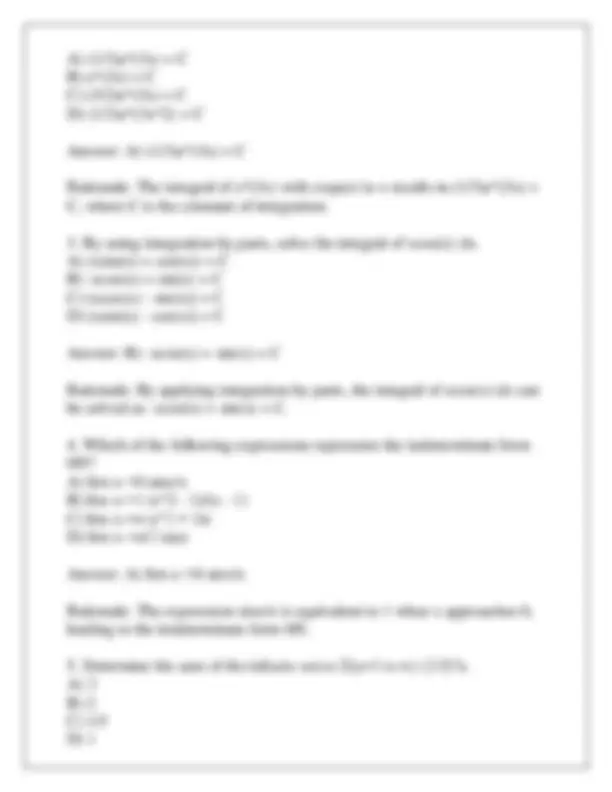
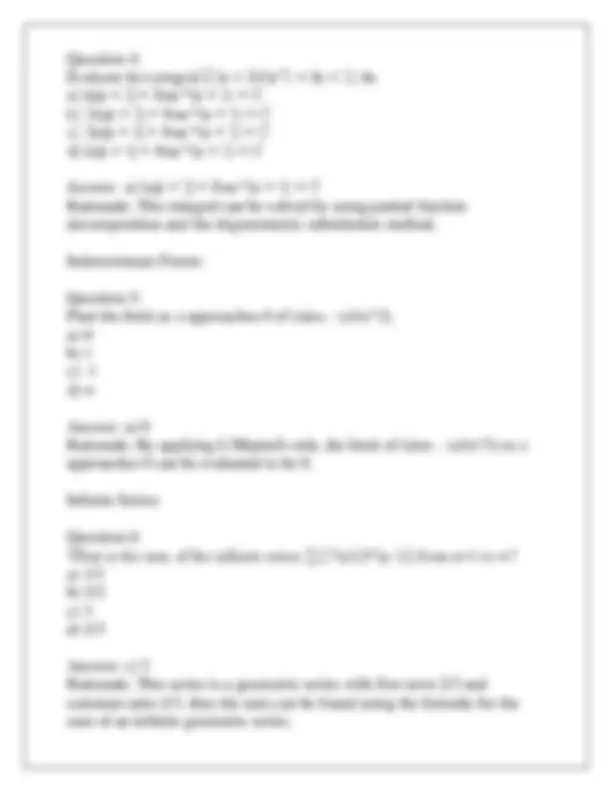
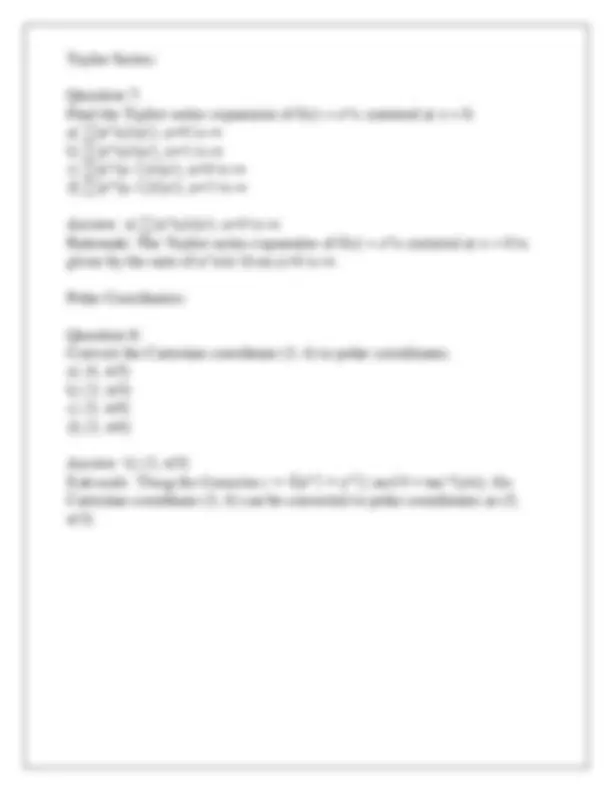


Study with the several resources on Docsity

Earn points by helping other students or get them with a premium plan


Prepare for your exams
Study with the several resources on Docsity

Earn points to download
Earn points by helping other students or get them with a premium plan
Community
Ask the community for help and clear up your study doubts
Discover the best universities in your country according to Docsity users
Free resources
Download our free guides on studying techniques, anxiety management strategies, and thesis advice from Docsity tutors
A review exam for calculus ii with 10 questions covering various topics such as trigonometry, integration, limits, infinite series, techniques of integration, indeterminate forms, taylor series, and polar coordinates. Each question includes a detailed solution and rationale.
Typology: Exams
1 / 9

This page cannot be seen from the preview
Don't miss anything!






D) It diverges by the ratio test Answer: A) It converges to 1/ Rationale: To test the convergence of the series, we can use the comparison test with a simpler series that has the same behavior as n goes to infinity. A good choice is ∑(n=1)^∞ 1/n^2, which is a p-series with p = 2 > 1, so it converges. To compare the two series, we need to find the limit of the ratio of their terms, which is lim(n->∞) ((n^2 + 1)/(n^4 + 2n
A) (1/3)e^(3x) + C B) e^(3x) + C C) (3/2)e^(3x) + C D) (1/3)e^(3x^2) + C Answer: A) (1/3)e^(3x) + C Rationale: The integral of e^(3x) with respect to x results in (1/3)e^(3x) + C, where C is the constant of integration.
c) 1 d) 1/√ Answer: a) √3/ Rationale: The exact value of sin(π/3) is √3/2, which is the y-coordinate of the point on the unit circle corresponding to the angle π/3. Question 2: If tan(θ) = 3/4, what is the value of cos(θ)? a) 3/ b) 4/ c) 5/ d) 5/ Answer: b) 4/ Rationale: Given tan(θ) = 3/4, we can use the Pythagorean identity to find cos(θ) = 4/5. Applications of Integration: Question 3: A tank is in the shape of an inverted circular cone with height 10 meters and base radius 5 meters. If the tank is being filled with water at a rate of 3 cubic meters per minute, how fast is the water level rising when the water is 6 meters deep? a) 0.2 m/min b) 0.3 m/min c) 0.4 m/min d) 0.5 m/min Answer: c) 0.4 m/min Rationale: This problem can be solved using the concept of related rates and the formula for the volume of a cone. The rate at which the water level is rising can be found by differentiating the volume formula with respect to time. Techniques of Integration:
Question 4: Evaluate the integral ∫(2x + 3)/(x^2 + 3x + 2) dx. a) ln|x + 2| + 3tan⁻¹(x + 1) + C b) 2ln|x + 2| + 3tan⁻¹(x + 1) + C c) 2ln|x + 1| + 3tan⁻¹(x + 2) + C d) ln|x + 1| + 3tan⁻¹(x + 2) + C Answer: a) ln|x + 2| + 3tan⁻¹(x + 1) + C Rationale: This integral can be solved by using partial fraction decomposition and the trigonometric substitution method. Indeterminate Forms: Question 5: Find the limit as x approaches 0 of (sinx - x)/(x^3). a) 0 b) 1 c) - 1 d) ∞ Answer: a) 0 Rationale: By applying L'Hôpital's rule, the limit of (sinx - x)/(x^3) as x approaches 0 can be evaluated to be 0. Infinite Series: Question 6: What is the sum of the infinite series ∑(2^n)/(3^(n-1)) from n=1 to ∞? a) 1/ b) 3/ c) 3 d) 2/ Answer: c) 3 Rationale: This series is a geometric series with first term 2/3 and common ratio 2/3, thus the sum can be found using the formula for the sum of an infinite geometric series.